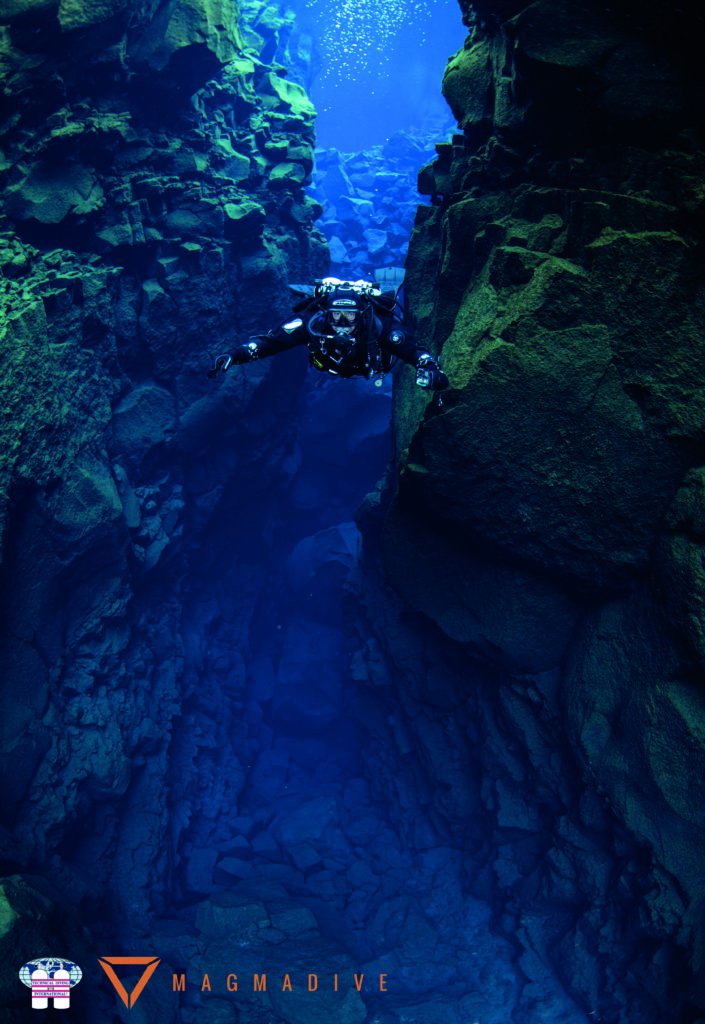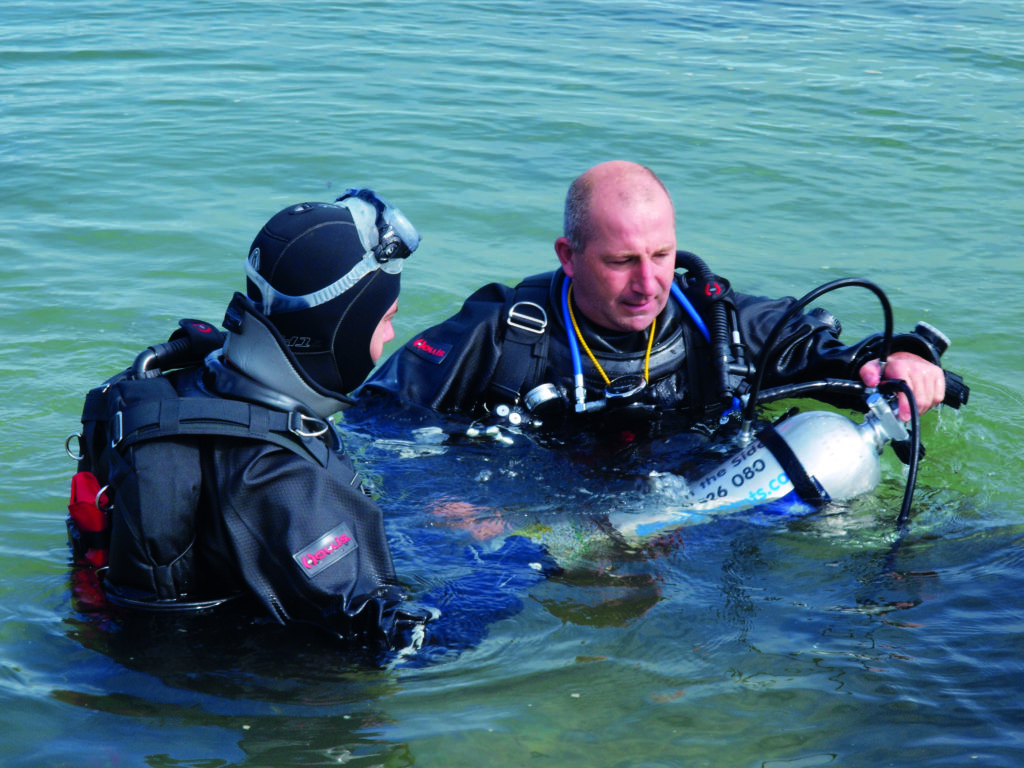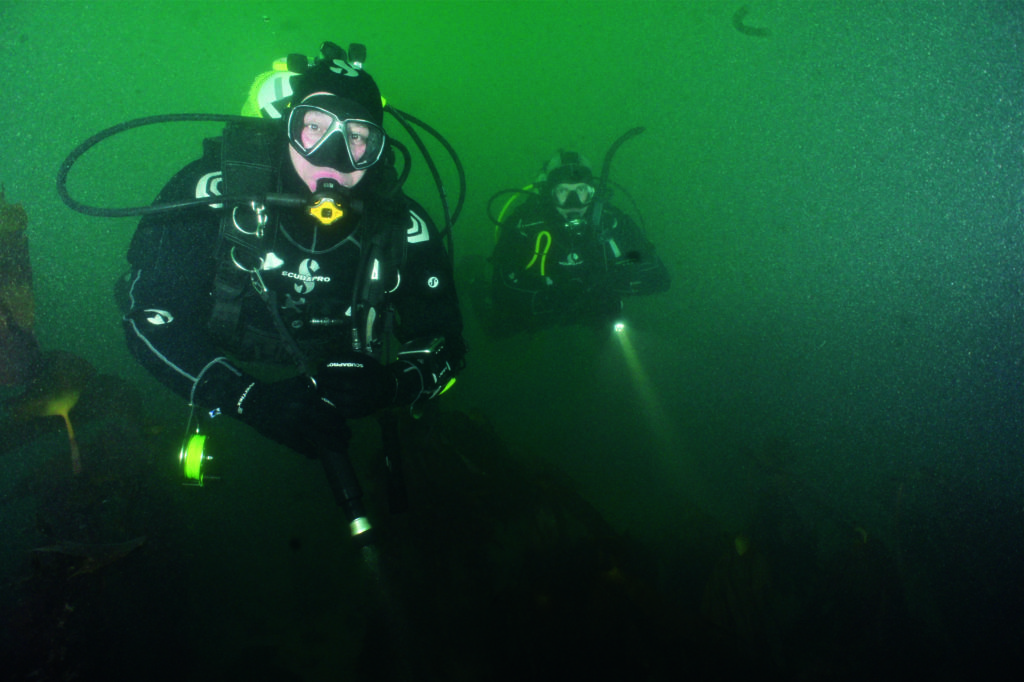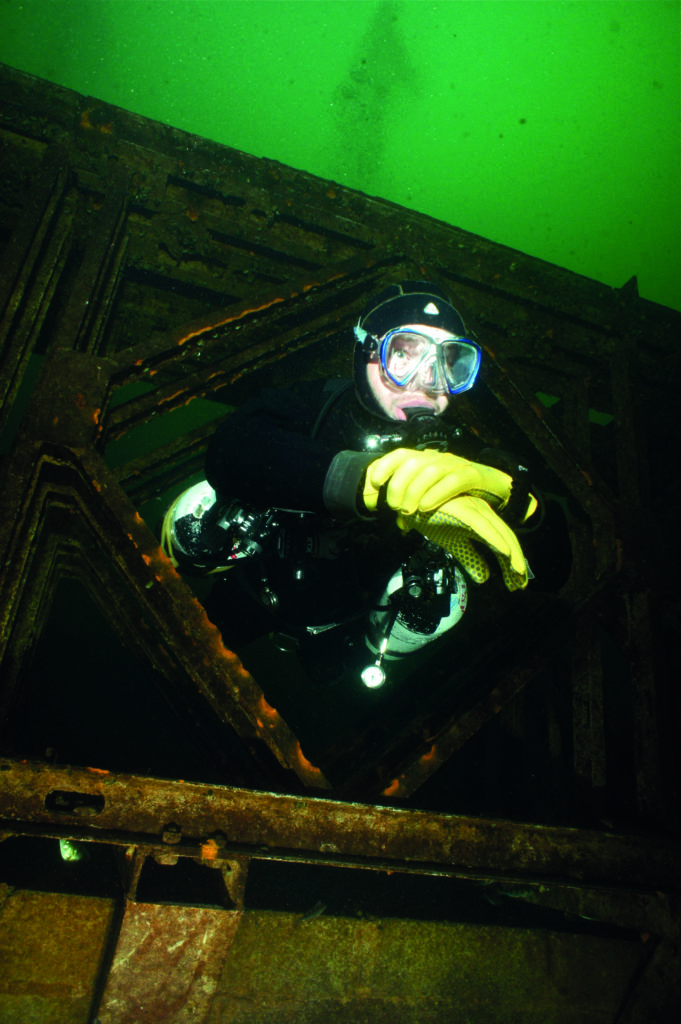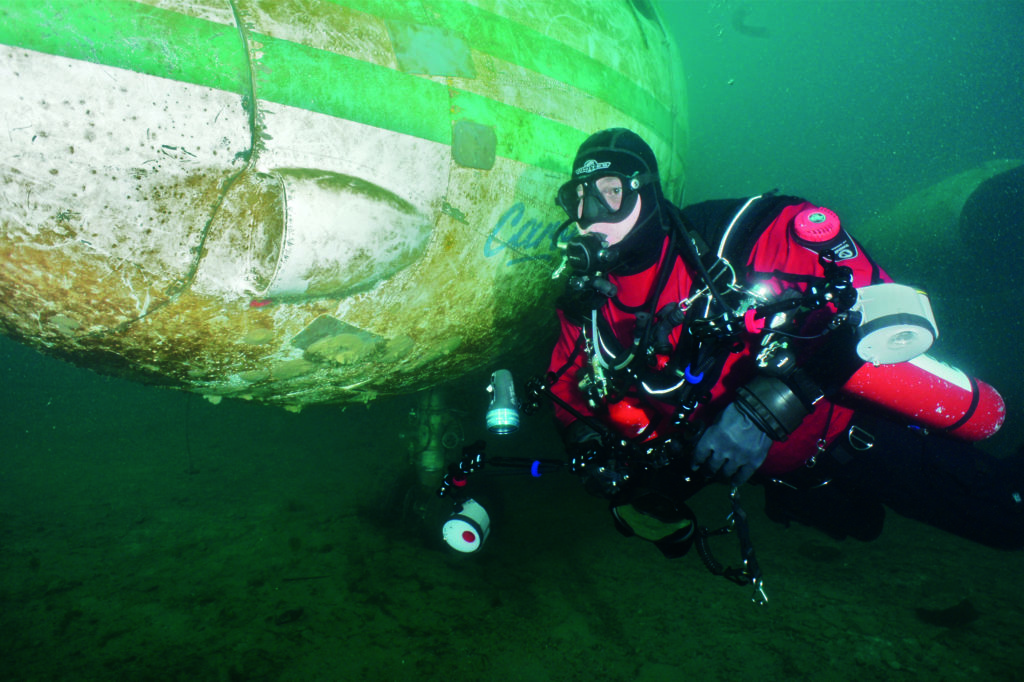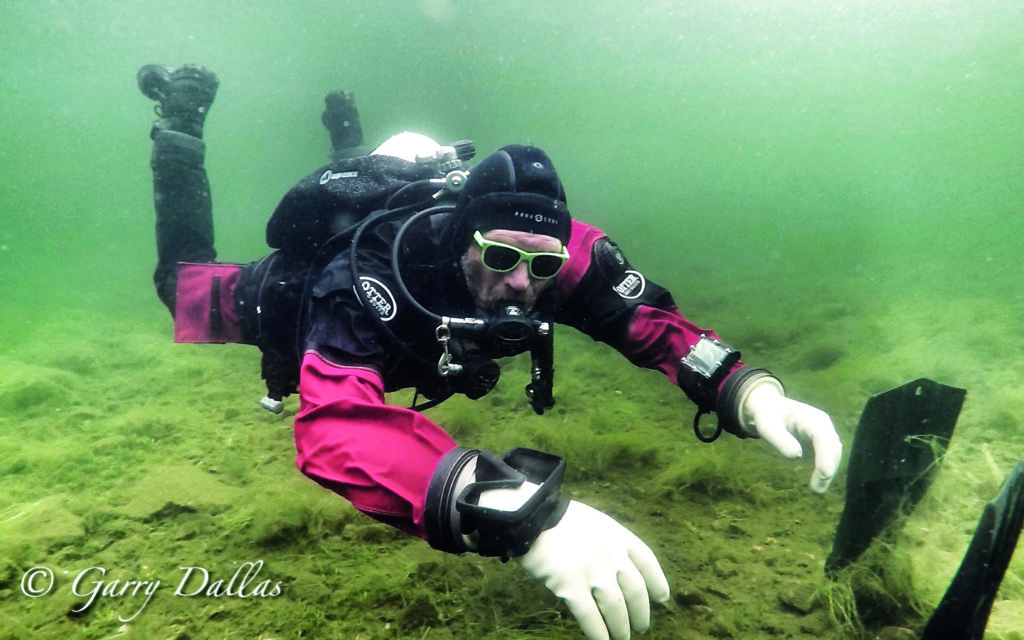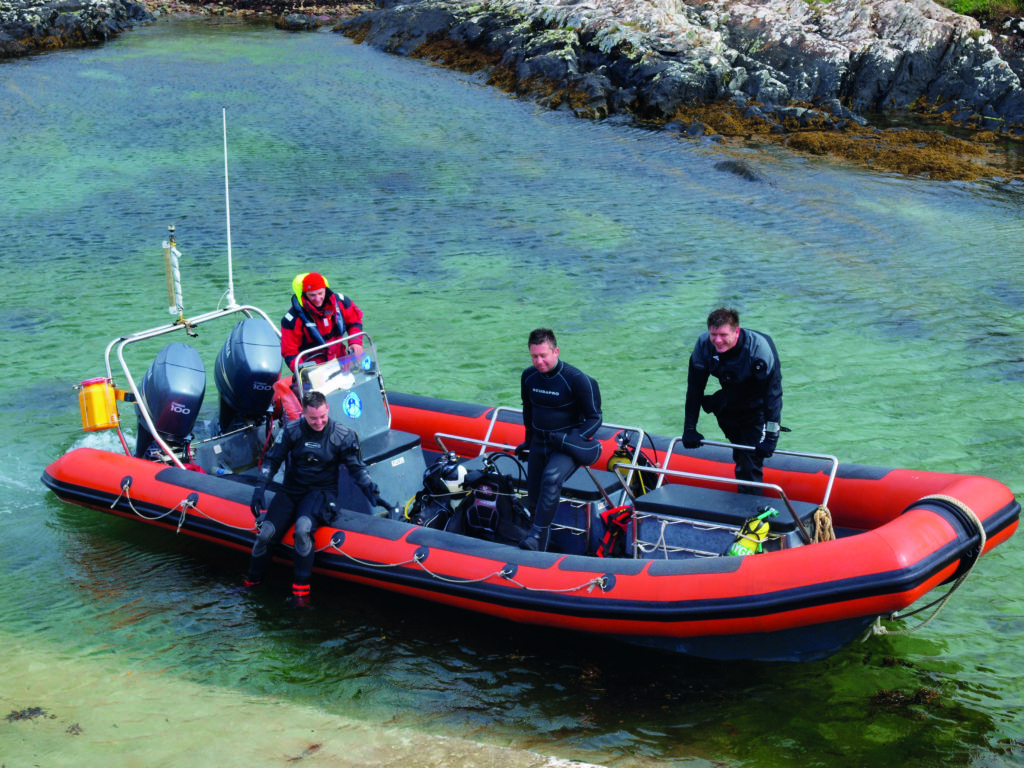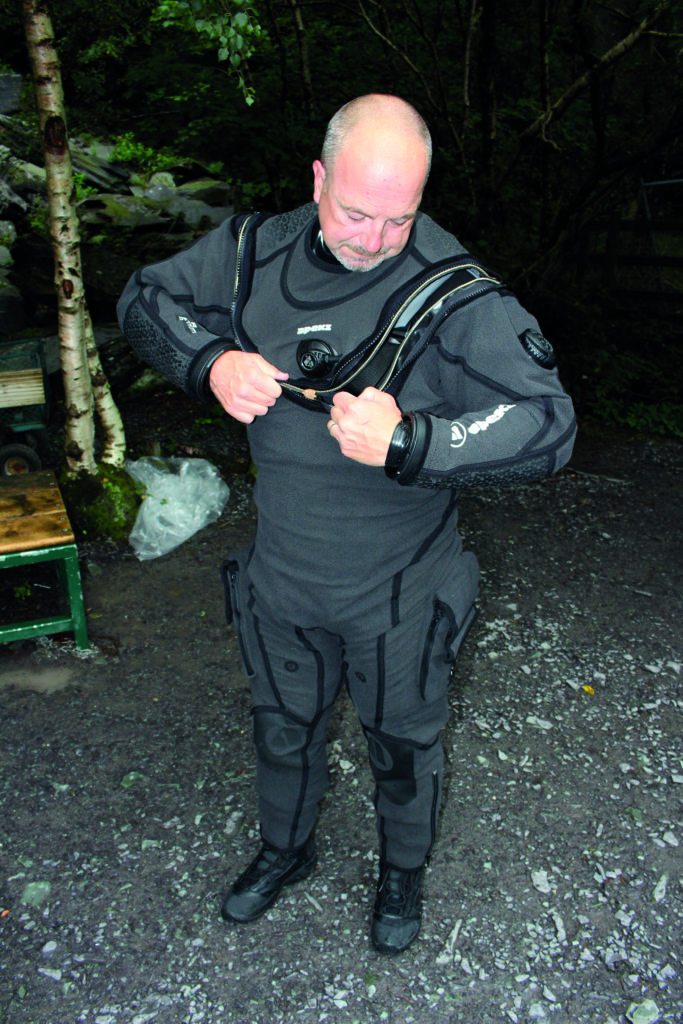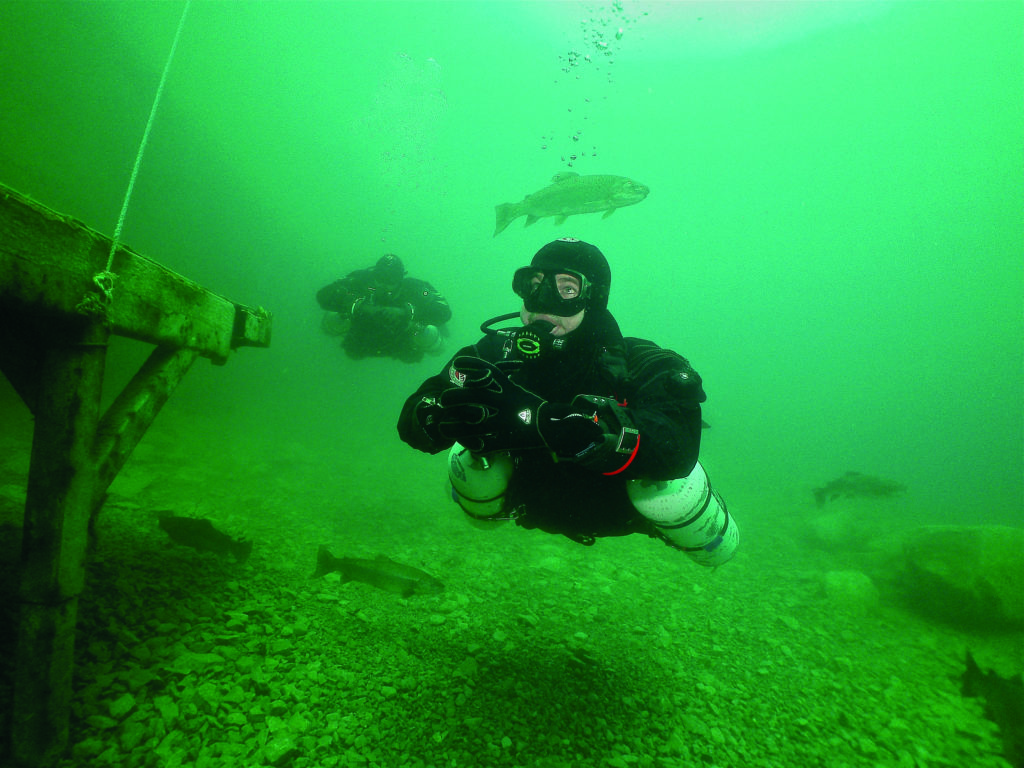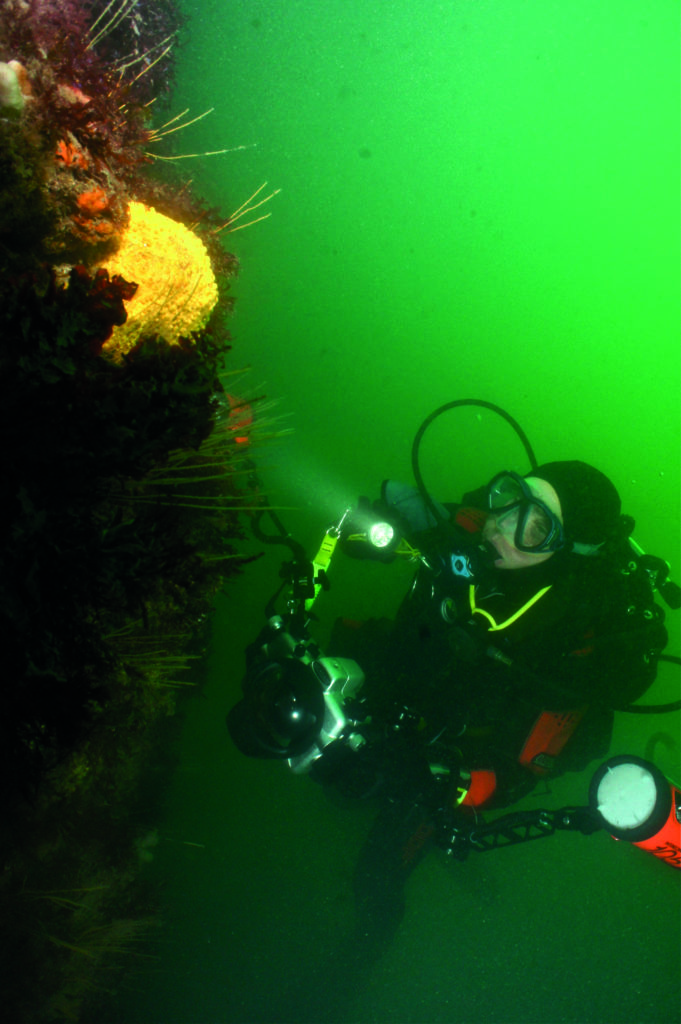Want to maximise your comfort, warmth and safety under (as well as out of) the water, and all without buoyancy issues? The experts have the comprehensive advice you need
A drysuit should be in every UK diver’s arsenal, because there’s little worse than feeling cold whether on a dive or when you exit the water. No amount of neoprene in a wetsuit or semi-dry is going to keep you as warm and toasty as a well-fitting drysuit.
However, some divers still seem to retain an inherent fear of drysuits. This is odd, because with a little tuition and practice diving in one is a doddle, and you can soon be happy bouncing back and forth between wet- and drysuits.
Also read: Latest Hammond suited to travelling divers
And remember, drysuits are not only for UK or real coldwater diving. You will also find that diving in a drysuit in, for instance, the Med in winter is far preferable to layering up the neoprene.
PADI TecRec Instructor Trainer Martin Robson: “Drysuits are designed to keep you dry and, with the right undersuit, warm too, so use the suit to keep you dry and insulated and not for buoyancy. That is what your wing/BC is designed for.
“Less air in your suit will make trim and buoyancy easier to control. Unless you’re very well-practised, leave your drysuit dump-valve open so that you can vent gas from the suit quickly should you need to.”
PADI UK Regional Manager Matt Clements: “Cannot stress this enough, buy your own suit and make sure it fits you. Often hired suits leak, which is mostly due to poor fit. It is never fun to go in for a second or third dive wet and cold.
“When it’s your own suit, you can trim the seals to fit you. Wrist- and neck-seals also tend to be the weak spots, so keep an eye on their condition because you can repair them pre-dive rather than at the water’s edge (unless you have a quick-change system).
“Now I dive with dry gloves, pee-valve and a heated vest – why suffer? I would much rather not need the extras than be in deco wishing I did!”
PADI Dive Director & TecRec Instructor-Trainer Alan Whitehead: “Drysuit training is essential, but although it affects buoyancy please try not to use it primarily for your buoyancy, because this could lead to too much air in the suit, which can easily migrate to ‘problem’ areas, such as your feet.
“It is also not as easy to dump as a wing/BC during ascent. Start with small amounts of air in the suit for comfort and warmth, but just enough to avoid squeeze.”
Emily Petley-Jones, PADI UK Regional Training Consultant: “Look after your zip. This is the most expensive part of your drysuit to fix if it breaks. When storing your suit, leave the zip open and don’t bend it back on itself.
“With my back-entry zip I roll the legs up into the chest, then wrap the arms around the outside to avoid the zip getting bent. Don’t forget to wax it, either!”
Vikki Batten, PADI Director of Rebreather Technologies, Training Supervisor & Instructor-Examiner: “If you find your feet are a ‘little’ floaty in a drysuit, instead of pushing your legs down, which risks cramping, try looking up slightly. With a cylinder on your back, this tips your hips down slightly and your legs will follow.
“Of course, this works only for minor problems – if it gets worse, you might have to ‘roll’”.
TDI/SDI Business Development Manager Mark Powell: “Much of the advertising you see for diving involves warm water and divers in swimsuits or thin wetsuits. It can be a shock to those divers who were certified in warm water to come back to the UK and discover that the water is a bit cooler.
“For those of us who dive and teach in the UK or Europe, talking about the differences is much like talking about how to choose a mask. We are often asked about the differences between diving wet and diving dry. Of course, there are some key differences.
“Warmth: This is probably the most important reason to decide to dive dry. You know that neither a wetsuit nor drysuit actually keeps you warm. What they do is slow the amount of heat loss. Wetsuits do this by using a layer of neoprene and a thin layer of water trapped between that and the skin.
“Drysuits use air and a combination of undergarments – no water to take heat away if a seal is lost and allowed to flush through the suit. With drysuits you can add layers of insulation to slow the loss of body heat.
“Buoyancy: Wetsuits compress with depth, and lose some of their inherent buoyancy. Drysuits allow the diver to add air and compensate for the increased pressure at depth. As the wetsuit compresses, it gets thinner and loses insulating capacity. The drysuit does not.
“Weighting: Once a diver has become proficient with a drysuit, over-weighting is not as much of a concern as it is with a wetsuit. As a wetsuit loses buoyancy at depth, a diver can become seriously over-weighted due to suit compression.
With a drysuit, the amount of buoyancy the suit offers stays more or less constant, because the diver has the means to adjust for the increased/decreased pressure.
“Varying conditions: A large benefit of a drysuit is the ability to use it in various conditions. A wetsuit doesn’t offer the flexibility of a drysuit to add or subtract undergarments to suit the water/surface conditions. Many divers use their drysuit year-round, from warmwater locations to under the ice in winter.
“Purchase cost: At one time, drysuits were prohibitively expensive for the average diver. One could purchase several wetsuits for the cost of one drysuit – and they often had to do that, if diving in a wide range of water temperatures!
“With the introduction of new materials and manufacturing competition, a good-quality entry-level drysuit can be had for roughly the same price as a higher-end wetsuit.
By varying the undergarments, the diver can also avoid having to buy several different thicknesses of wetsuits. One drysuit will work in numerous environments.
“Cost of ownership: Once a diver buys a wetsuit there is very little maintenance needed other than proper rinsing. Drysuits require seals to be replaced; leaks attended to; boots, socks and maybe even the zip replaced. These costs might be offset by the life of the suit.
“Drysuits, with proper care, can last 15-20 years or more. This is using the suit on a regular basis – say for 100 dives a year. A wetsuit seeing that much use might last five years. In the long run, a drysuit might actually be less expensive.
“Drysuits often hold their value for resale. Used wetsuits get tossed, but used drysuits are sold to offset the cost of a new one!
“Whether you’re a prospective or a new drysuit diver, you’ve likely heard a few outrageous stories about the potential challenges that come with diving a drysuit, specific to body position or ‘trim’.
“So maybe you’ve heard that once you dive dry ‘there is no way you can reach your valve(s)’, or some dramatic story of a diver having too much gas in their feet and rocketing towards the surface upside-down.
“Sure, each of these scenarios is possible, but they can be easily avoided with a combination of a properly fitting suit, adjusting your cylinder position and weight placement, honing in on your drysuit-diving skills and technique, and gaining more experience. In time, you can dive a drysuit just as easily as a wetsuit.”
Garry Dallas, Director of Training RAID UK (Recreational/Technical/ Cave Instructor-Trainer): “The purpose of a drysuit is in the name, to keep you dry! This is often mistaken for other attributes, such as keeping you warm, which is actually the purpose of the undersuit.
“There are various drysuits on the market, with all the bells and whistles, but the most important features are often overlooked. Neoprene suits have a place in recreational diving but membrane / trilaminate suits are best suited for technical and/or recreational diving.”
“Whichever suit you choose, important factors include in-water comfortable flexibility; tailored fit throughout the body (especially under the crotch and armpit) to prevent restrictions on movement; constant neutral buoyancy characteristics at depth; pocket accessibility; ease of donning and doffing with telescopic front/back entry; self-replaceable seal material; durability; zip material and quality. When it comes to repairs/warranty, customer service is up there too.”
“When you’ve chosen your first drysuit, train to use it. Ability to dive well in a wetsuit is one thing, but drysuits are a different ball-game. However, once mastered, hovering in a drysuit is the most pleasurable experience and will open up a whole new world of diving.”
“To keep your drysuit seals in tip-top condition, periodically check wrist- and neck-seals for deterioration, splitting, dozing and cracking of rubber, and avoid prolonged exposure to sunlight and chemicals.”
“Regular lubrication with bee’s wax increases the life of the zip teeth and smooth operation of the zip, while preventing fraying. Suit-inflator and dump-valves need checking for proper operation.”
“The suit could develop a leak anywhere but commonly valves, the soles of boots or socks, seals, seams on the crotch, armpit or zip area and even delamination of the material can occur.”
“The best solution is to take your suit to your reputable dealer or repair centre and let the experts sort it out for you. Let them check it over annually, because time alone without use will deteriorate a suit.”
Alex ‘Woz’ Warzynski, BSAC Advanced Instructor: “One of the most common questions I get asked is ‘Which drysuit should I buy?’ and the answer is: ‘Well, it depends on the type of diving you do.”
“If travel is important, a lightweight suit that folds up small is a high priority. If your thing is squirrelling around wrecks, a suit that doesn’t snag and stands up to sharp edges is important.”
“If you’re diving in a high-current area, a close-fitting, streamlined suit would be best so that you can whizz about with minimal resistance. Diving a twinset? Pick a suit with lots of flexibility in the upper body for shutdowns.”
“For UK diving, where you’re likely to be spending all day in your suit, the most important thing is fit and comfort, both in and out of the water. Getting into and out of it should be simple, and it should have a way of staying up when the top half is undone.”
“Neoprene neck-seals, especially the comfortable super-stretchy ones, stop the hangman’s-noose effect that you can get from the irritation from latex.”
“Once submerged, you need to be weighted properly and add just enough gas to the suit to take the squeeze off. Otherwise, you end up with large volumes of air migrating round it and this can, for inexperienced divers, lead to difficulty with buoyancy control.”
“For compressed neoprene suits, a little extra weight will be needed to get you off the surface (and keep you on your safety stop) as the suit material compresses at depth. This isn’t a problem with membrane or crushed neoprene.”
“For warmth, I’m a big fan of layering. A Merino base-layer to start, a mid-layer if it’s really cold, then your main outer undersuit on top. Just add and remove layers as the temperature varies, and change your weighting to suit. Good notes in your logbook help with this.”
“A close, tight fit works best with undersuits, and choose them carefully to maintain flexibility while still retaining some structure to resist the force of the drysuit pressing down, because it’s the air layer that keeps you warm.”
John Kendall, GUE Instructor-Trainer: “Many things can make a drysuit great or terrible, and the first is the fit.”
“Some manufacturers make their suits baggy, some make them tight, some cut the arms one way, others do it differently. I am very, very fussy when it comes to the fit of my drysuits, and make sure that they will be cut to allow me full overhead movement of my arms. Without a good fit, the drysuit is pretty useless.”
“The zipper is the next thing that can make a big difference to how good a suit is. I don't like rear zips, because it means I’m reliant on other people to help me in and out of my suit, and they also stiffen up the shoulders and make reaching valves hard.”
“The last thing is the position of the dump-valve. For me, it should be on the outside of the bicep. That way I can simply lift my left elbow to dump gas, and not have to contort myself to get the gas out.”
“When you find a good drysuit that fits you well, with a good zip and proper dump-valve placement, you should look after it. Don't be afraid to invest in servicing before things go wrong.”
“I replace the seals on my suits every 200 dives or so (which means about six months for me) to make sure that I’m never surprised by a ripped seal just before what turns out to be, for my buddies, an awesome dives.”
“If you’re a regular diver, it might be worthwhile investing in a second drysuit, so that you never have to miss a dive while one is being serviced.”
IANTD Instructor-Trainer Ian France: “The drysuit is an essential part of many diving scenarios. Despite offering both thermal insulation and redundant buoyancy, it’s an often-overlooked piece of equipment because of the relatively high cost of a decent product.”
“With increased redundancy becoming the norm in diving, meaning divers carrying two of all essential kit, it is only realistic to take one drysuit.”
“A poorly fitting drysuit will often result in the diver being restricted, preventing management of other equipment effectively, for example. the ability to manipulate valves while diving back-mounted cylinders, and to effectively manage a divers’ stable platform, resulting in poor trim and buoyancy.”
“In turn, this decreases the diver’s ability to manage simple tasks under water, resulting in additional stress.”
“Poor drysuit maintenance also increases the likelihood of zip or dump failure, while carelessness can result in damage and leaks. A failed drysuit on a dive can lead to potential hypothermia, negative buoyancy or, at least, increased thermal stress affecting decompression efficiency.”
“However, a little care with simple maintenance after each dive can prolong the life of this important investment for many years. Remove equipment from the pockets after each dive, rinse off salt, lubricate the zip as per manufacturer’s instructions and store dry, preferably hanging. Inspect seals regularly and attend to nicks before they become splits or perish.”
“Your drysuit is fundamental to your underwater comfort and safety – treat it well.”
The Sub-Aqua Association’s Gary Asson: “There are two main types of drysuit in use today, neoprene and laminate. Neoprene has the better thermal insulation, but loses out on flexibility and weight.”
“My preference is for crushed neoprene, which has good thermal insulation and flexibility. When it comes to maintenance, both materials need to be completely dry before a repair can be made. This can usually be quickly achieved with a wipe over in the case of laminate, but can take a considerable amount of time in the case of neoprene.”
“Ideally a drysuit should be made to measure but this is associated with additional cost. Regardless of whether your drysuit is made to measure, off the peg, or secondhand, don’t forget that you will require additional insulation, and that if you intend to dive in UK waters all year round, this requirement will change.”
“Make sure it still fits, and that you can perform any shutdowns etc when you’are wearing your winter gear. Also, make sure that the suit doesn’t have large spaces where air can migrate, causing buoyancy problems.”
“Pockets are a very useful addition. Being able to stow a DSMB in a pocket ready to go makes life easier. Make sure that you can open and close them with cold, wet hands, and wearing thick gloves.”
“Controlling buoyancy under water in drysuit diving can be achieved by using the drysuit only (the jacket is used only at the surface), or by a mixture of using the jacket for buoyancy and adding air to the suit only to stop squeeze.”
“The advantage of drysuit-only is that you need only consider the gas in your drysuit, whereas when adding air to both drysuit and jacket, you need to consider both. As always, this is a mixture of personal choice, and the type of diving you do.”
“Being able to control the amount of air being dumped from the suit is an important decision. When I first started diving, we had the cuff-dump. Later a friend of mine announced that all his buoyancy problems were over. He had just bought a suit with an ‘auto-dump’ that would magically release the correct amount of air for him. That was a giggle.”
“Moving to a drysuit requires practical training from a competent instructor to master the basics. Then, practise, practise, practise. Build up experience until it is second nature, before putting yourself into a position in which buoyancy failure could put you in danger.”
“I have always used the drysuit-only method. This was the way I was taught, and I have found that even with three stages/bail-out bottles, I can still maintain buoyancy comfortably. This was until October, when diving in fresh water in Mexico.”
“I had lost a few pounds and didn’t need the usual insulation because of the water temperature, but wanted the insulation of the drysuit so that I could extend the dive-times and stay comfortable. Even without any weights, I was considerably overweighted.”
“Using the suit only meant that air sometimes dumped from the neck, and/or migrated everywhere. This made for some interesting diving.”
“I handled the situation, but it wasn’t ideal. I have now started to look at ‘drysuit for squeeze and jacket for buoyancy’. However, trying to break 25 years-plus of muscle memory is taking time!”
Photographs by Mark Evans
Also on Divernet: Never Had It So Good

